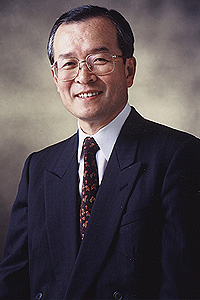Yamamoto receives three awards for his creativity in chemistry, designing efficient chemical synthesis
By Steve KoppesNews Office
 Hisashi Yamamoto | |
Career achievements in exploring the world of designer molecules this year has earned University chemist Hisashi Yamamoto three awards from across the globe.
On June 11, Yamamoto will receive a 2007 Japan Academy Prize in Tokyo, at a ceremony that the emperor and empress of Japan will attend. In August, he travels to Boston, where he will receive the 2006 Tetrahedron Prize for Creativity in Organic Chemistry Award at a meeting of the American Chemical Society. Yamamoto also has earned a 2007 Humboldt Research Award from Germany’s Alexander von Humboldt Foundation.
Yamamoto, the Arthur Holly Compton Distinguished Service Professor in Chemistry and the College, designs molecules the way an architect designs buildings. “Chicago is quite famous for architecture, so why not for molecules?” Yamamoto asked.
Although molecules are invisible to the naked eye, their design can be just as beautiful or as useful as a building. One product created in Yamamoto’s laboratory, for example, makes it possible to synthesize a certain molecule in three steps instead of 15 or more.
“Usually we have to do one reaction in one flask,” Yamamoto said. But as part of an effort to increase the efficiency of chemical synthesis, his research group has designed a molecule that can trigger three or four reactions in one flask. “We call this the cascade reaction,” Yamamoto said.
The pharmaceutical industry uses some of the molecules that Yamamoto has designed, but his research group pursues a range of projects. “I don’t like to specify one particular molecule or one particular target. At this moment our group has two undergraduate students, 12 graduate students, two postdoctoral fellows, and everybody is doing something different,” he said. Their projects are all rooted, though, in the chemistry of acids that play an important role in triggering or driving chemical reactions.
Among his current challenges: to develop experimental methods that do not require the use of poisonous metallic elements to trigger chemical reactions of scientific interest.
“Aluminum or boron, these are OK. Silicons are OK. But if you have to use mercury, that’s not so good. We have to remove all these poisonous metals after the reactions,” Yamamoto said, in a time-consuming, resource-intensive process. “This is a really important project for the future,” he said. “I would say our goal is still far ahead.”
Yamamoto presides over his fourth-floor office in the Jones Laboratory building with an easy laugh. Works of Chinese brush writing decorate two walls. On one counter sits a bronze sculpture in the shape of a right hand. It is both a work of art and a proud honor, the 2003 Molecular Chirality Award of the Molecular Chirality Research Association.
The chirality concept reigns supreme in synthetic chemistry as well as biology. A molecule’s chirality—whether it is left- or right-handed—determines what reactions it can initiate. It all sounds so complicated, but Yamamoto invokes Alice in Wonderland to explain the concept.
“She gets inside the mirror, and the right hand is now the left hand, and the left hand is now the right hand,” he said. The simple act of reading becomes difficult for Alice, because some of the alphabet is chiral, and some of it is not. “The difference is, when you write it down on glass and then from the opposite side you can read it, that is achiral. But if you cannot, that is chiral.”
Two achiral characters of the Chinese alphabet greet visitors to Yamamoto’s Web site. The two characters, rendered in Chinese brush writing, proclaim in a word that the most important moment in life is now. It is a philosophy that Yamamato’s group seems to have embraced. “Almost every day we have exciting findings,” he said.
![[Chronicle]](/images/sidebar_header_oct06.gif)